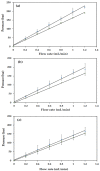Polystyrene -co- Divinylbenzene PolyHIPE Monoliths in 1.0 mm Column Formats for Liquid Chromatography
- PMID: 28773337
- PMCID: PMC5456711
- DOI: 10.3390/ma9030212
Polystyrene -co- Divinylbenzene PolyHIPE Monoliths in 1.0 mm Column Formats for Liquid Chromatography
Abstract
The reversed phase liquid chromatographic (RP-HPLC) separation of small molecules using a polystyrene-co-divinylbenzene (PS-co-DVB) polyHIPE stationary phases housed within 1.0 mm i.d. silcosteel columns is presented within this study. A 90% PS-co-DVB polyHIPE was covalently attached to the walls of the column housing by prior wall modification with 3-(trimethoxysilyl) propyl methacrylate and could withstand operating backpressures in excess of 200 bar at a flow rate of 1.2 mL/min. Permeability studies revealed that the monolith swelled slightly in 100% acetonitrile relative to 100% water but could nevertheless be used to separate five alkylbenzenes using a flow rate of 40 µL/min (linear velocity: 0.57 mm/s). Remarkable column-to-column reproducibility is shown with retention factor variation between 2.6% and 6.1% for two separately prepared columns.
Keywords: isocratic separation; microbore; polyHIPE; polystyrene; reversed phase LC; silcosteel.
Conflict of interest statement
The authors declare no conflict of interest.
Figures




Similar articles
-
Chromatographic selectivity of poly(alkyl methacrylate-co-divinylbenzene) monolithic columns for polar aromatic compounds by pressure-driven capillary liquid chromatography.Anal Chim Acta. 2016 Oct 5;939:117-127. doi: 10.1016/j.aca.2016.08.034. Epub 2016 Aug 25. Anal Chim Acta. 2016. PMID: 27639150
-
Covalent attachment of polymeric monolith to polyether ether ketone (PEEK) tubing.Anal Chim Acta. 2016 Aug 17;932:114-23. doi: 10.1016/j.aca.2016.05.026. Epub 2016 May 24. Anal Chim Acta. 2016. PMID: 27286776
-
Semi-micro reversed-phase liquid chromatography for the separation of alkyl benzenes and proteins exploiting methacrylate- and polystyrene-based monolithic columns.J Sep Sci. 2016 May;39(9):1648-55. doi: 10.1002/jssc.201600049. Epub 2016 Apr 14. J Sep Sci. 2016. PMID: 26960001
-
Development of high internal phase emulsion polymeric monoliths for highly efficient enrichment of trace polycyclic aromatic hydrocarbons from large-volume water samples.J Chromatogr A. 2015 Jul 31;1405:23-31. doi: 10.1016/j.chroma.2015.05.067. Epub 2015 Jun 6. J Chromatogr A. 2015. PMID: 26077972
-
Porous monoliths: stationary phases of choice for high performance liquid chromatography in various formats.Se Pu. 2005 Nov;23(6):585-94. Se Pu. 2005. PMID: 16498986 Review.
Cited by
-
Influence of Functional Group Concentration on Hypercrosslinking of Poly(vinylbenzyl chloride) PolyHIPEs: Upgrading Macroporosity with Nanoporosity.Polymers (Basel). 2021 Aug 14;13(16):2721. doi: 10.3390/polym13162721. Polymers (Basel). 2021. PMID: 34451260 Free PMC article.
-
Poly(hydromethylsiloxane) Networks Functionalized by N-allylaniline.Int J Mol Sci. 2025 Jul 12;26(14):6700. doi: 10.3390/ijms26146700. Int J Mol Sci. 2025. PMID: 40724950 Free PMC article.
-
Macroporous Polymer Monoliths in Thin Layer Format.Polymers (Basel). 2021 Mar 27;13(7):1059. doi: 10.3390/polym13071059. Polymers (Basel). 2021. PMID: 33801786 Free PMC article. Review.
-
Effect of shearing stress on the radial heterogeneity and chromatographic performance of styrene-based polymerised high internal phase emulsions prepared in capillary format.RSC Adv. 2019 Mar 5;9(13):7301-7313. doi: 10.1039/c8ra06188b. eCollection 2019 Mar 1. RSC Adv. 2019. PMID: 35519965 Free PMC article.
-
Styrene-based polymerised high internal phase emulsions using monomers in the internal phase as co-surfactants for improved liquid chromatography.RSC Adv. 2022 Mar 29;12(16):9773-9785. doi: 10.1039/d1ra07705h. eCollection 2022 Mar 25. RSC Adv. 2022. PMID: 35424961 Free PMC article.
References
LinkOut - more resources
Full Text Sources
Other Literature Sources

